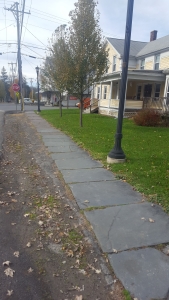Bluestone sidewalks
The Catskill geologists; Jan. 2019
Robert and Johanna Titus
Do you remember the words from Joanie Mitchell’s old song “Big Yellow Taxi?” “You don’t know what you’ve got ‘til it’s gone.” We certainly learned that when Hurricane Irene destroyed the old covered bridge at Blenheim. It was one of the last few such bridges in our region. Once there were many of them, but now they are all nearly gone. Long ago, people would have just taken each of them for granted. Then they were, one after another, taken down and replaced by far more modern bridges. That was chalked up to “progress.” Then they were nearly gone, and we came to know what we had, but only after it was nearly gone.

How many times have you seen “We buy old barns” signs along the highways? Old barns can be torn down and their wood commands a premium price. Do you take much notice when you pass an old barn? Perhaps you won’t notice any of them until they are nearly gone. We fear that may well happen. It’s a sad thought.
Why are we talking about these things in what is supposed to be a geology column? Well, for a very good reason. Our region was once densely dotted with bluestone sidewalks. There had been a very large bluestone industry throughout the Catskills and much of that industry was devoted to making stone slabs for those sidewalks.
We have written about bluestone a number of times in this column. It’s a form of sandstone that was deposited in river channels that crisscrossed the Devonian aged Catskill Delta that once covered the Catskills region. That was back about 375 million years ago. Bluestone made a very good sidewalk material; it was tough stuff and held up very well under long periods of heavy use. It did not get slippery when wet, so people didn’t much have to worry about falling. And it was good looking, adding to our region’s rustic beauty. But then bluestone sidewalks began to disappear. And then a lot of them followed.
Good quality cements came along, and they could be turned onto fine sidewalk slabs. When an old bluestone sidewalk wore out, it was only sensible to replace it with cement. Progress had struck again. These modern cement sidewalks work just fine, and they are less expensive. But they just aren’t the same. Walk a cement sidewalk and see if you can feel the absence that the two of us feel. There is little beauty in cement, there is none of bluestone’s rusticity and nothing that can be called heritage. There is just a palpable absence in cement. And the more you think about it, the more you notice it.
Don’t get us wrong; we are realists. We know the era of bluestone is over. It will not likely return. Our efforts here are simply to call your attention to these old sidewalks. You cannot likely pass a covered bridge without noticing it, but it is easy to miss a bluestone sidewalk. We would like it if you looked around and watched for bluestone in your neck of the woods. We are fortunate to have a good one in our hometown of Freehold. See our photo. Perhaps you can find one near your home. We hope so; let us know if you do.
Contact the authors at randjtitus@prodigy.net. Join their facebook page “The Catskill Geologist.” Read their blogs at “thecatskillgeologist.com.”





